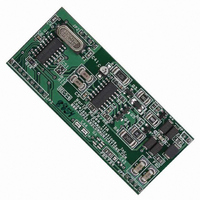CC-2401K2A-CS Copeland Communications Inc, CC-2401K2A-CS Datasheet - Page 20

CC-2401K2A-CS
Manufacturer Part Number
CC-2401K2A-CS
Description
MODEM 2400BAUD SECURE 3.3V
Manufacturer
Copeland Communications Inc
Datasheet
1.CC-2401K2A-CS.pdf
(66 pages)
Specifications of CC-2401K2A-CS
Data Format
V.21, V.22, V.23, Bell 103
Baud Rates
2.4k
Interface
UART
Voltage - Supply
3 V ~ 3.6 V
Mounting Type
Surface Mount
Package / Case
Module
For Use With
539-1002 - KIT EVALUATION WORLD MODEM II
Lead Free Status / RoHS Status
Contains lead / RoHS non-compliant
Other names
539-1010
CC-2401K2A-CS
CC-2401K2A-CS
© 2007, Copeland Communications, Inc.
using the “+++” or “ninth-bit” is not recommended because characters could be sent to and misinterpreted by
the remote modem. Only the “escape pin” <SC> is recommended for use in the “!2” mode. The “!1” mode
has a special escape provision described below. The AT commands for Alarm Industry applications are
described in the following table.
!1
Dial number and follow the DTMF security protocol. The format for this command is as follows:
The modem dials the phone number and returns “r” (ring), “b” (busy), and “c” (connect) as appropriate. “c”
returns only after the modem detects the Handshake Tone. After a 250 ms delay, the modem sends the
DTMF tones containing the first message data and listens for a Kissoff Tone. If a Kissoff Tone shorter than or
equal to the value stored in S36(KTL)(default = 1 second) is detected, the CC-2401 echoes a “K”. A “k” is sent
if the length of the Kissoff Tone is longer than the S36(KTL) value. The controller can then send the next
message. All messages must be preceded by a “!” and followed by a <CR> and received by the CC-2401
within 250 ms after the “K” is echoed. Setting S0C[0](MCH) = 1 causes a “.” to be echoed when the DTMF
tone is turned on and a “/” character to be echoed when the DTMF tone is turned off. This helps the host
monitor the status of the message being sent. The previous message can be resent if the host responds with
a “-“ after the CC-2401 echoes a “K”. Any character other than a “!” or a “~” sent to the modem immediately
after the “K” causes the modem to escape to the command mode and remain off hook. Any character except
“!” and “~” sent during the transmission of a message causes the message to be aborted and the modem to
return to command mode.
If the Kissoff Tone is not received within 1.25 seconds, the modem echoes a “^”. A “~” from the host causes
the last message to be resent. Any character other than a “!” or a “~” sent to the modem immediately after the
“^” causes the modem to escape to command mode and remain off hook.
!2
Dial the number and follow the “SIA Format” protocol for Alarm System Communications.
The modem dials the phone number and echoes “r” (ring), “b” (busy), and “c” (connect) as appropriate. “c”
echoes only after the CC-2401 detects the Handshake Tone and the speed synchronization signal is sent.
The signaling is at 300 bps, half-duplex FSK. The host can send the first SIA block after the “c” is received.
Once the block is transmitted, the modem can monitor for the acknowledge tone by completing the following
sequence:
1.
2.
3.
ATDT<phone number>!1<message 1><CR>
Place the CC-2501 in command mode by pulsing the ESCAPE pin. The “+++” and “ n inth-bit” escape
modes operate in the “!2” mode but are not recommended because they can send unwanted characters to
the remote modem.
Issue the “ATX1” command to turn the modem transmitter off and begin monitoring for the
acknowledgement tones.
Monitor for a positive (negative) acknowledgement “P” (“N”) after the tone has been detected for at least
400 ms.
K
!<message 2><CR>
K
!<message 3><CR>
K
K
!<message n><CR>
Command
!1
!2
X1
X2
X3
Function
Dial and switch to DTMF security mode
Dial and switch to “SIA Format”
SIA half-duplex mode search
SIA half-duplex return online as transmitter
SIA half-duplex return online as receiver
Page 20 of 66
Data Sheet
CC-2401K2 Datasheet Rev 1.5
CC-2401K2















